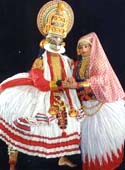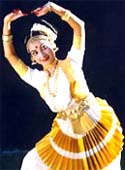|
Kathakali
Kerala is known
the world over
by its own
performing art
form, the
Kathakali. "Katha"
means story and
"Kali" stands
for dance. It is
a beautiful mix
of dance, drama
and music that
the connoisseurs
of art world
qualified as 'a
total art form
of immense
sophistication
and power'. This
is a form of
dance formerly
confined only to
the festival
stages in
temples. The
late Mahakavi
(great poet)
Vallathol
Narayana Menon
took special
interest in the
art, brought it
out of the
temples,
exploited its
antiquity and,
by unstinted
efforts, swe pt
the opera stages
all over the
world, bagging
great deal of
goodwill for
Kerala and
Malayalees. It
is a mime show,
dancing with
mudras
(formulated hand
gestures
conveying the
text of lyrics)
and specialised
dancing steps
following the
song rendered in
the background
by a singer to
the
accompaniment of
Chenda, Maddalam
(country drums),
Chenkila and
Elathalam
(Cymbals). Face
painted green
and made up with
spot of sacred
sandal paste on
the brow,
eye-lined with
mascara, lip
toned by cherry
and white chin
mask, the dancer
dons a colourful
costume and rich
and impressive
crown and
jewellery. A
traditional
pedestal
Nilavilakku (oil
lamp) with sixty
wicks on both
sides lit
together lights
the dancing
floor. There are
four types of
make up. pt
the opera stages
all over the
world, bagging
great deal of
goodwill for
Kerala and
Malayalees. It
is a mime show,
dancing with
mudras
(formulated hand
gestures
conveying the
text of lyrics)
and specialised
dancing steps
following the
song rendered in
the background
by a singer to
the
accompaniment of
Chenda, Maddalam
(country drums),
Chenkila and
Elathalam
(Cymbals). Face
painted green
and made up with
spot of sacred
sandal paste on
the brow,
eye-lined with
mascara, lip
toned by cherry
and white chin
mask, the dancer
dons a colourful
costume and rich
and impressive
crown and
jewellery. A
traditional
pedestal
Nilavilakku (oil
lamp) with sixty
wicks on both
sides lit
together lights
the dancing
floor. There are
four types of
make up.
Pachcha (green)
face painted
green and don
sober and
beautiful
attires denoting
the godly or
virtuous
character. Thadi
(beard);
divided into
Chuvanna Thadi
 (red
beard) depicting
aggressive and
demoniac
characters,
Karutha Thadi
(black beard)
depicting
aborigines,
cavemen and
foresters and
Vella Thadi
(white beard)
representing
Rishis, Saints,
Preceptors and
other
intellectuals.
Kari (carbon
black)
representing
mean characters
and Minukku
(refined)
presenting women
and Brahmins. (red
beard) depicting
aggressive and
demoniac
characters,
Karutha Thadi
(black beard)
depicting
aborigines,
cavemen and
foresters and
Vella Thadi
(white beard)
representing
Rishis, Saints,
Preceptors and
other
intellectuals.
Kari (carbon
black)
representing
mean characters
and Minukku
(refined)
presenting women
and Brahmins.
Mohiniyattom
 The sinuous
dance of the
enchantress,
this is a
distinctive
classical dance
form of Kerala.
Slow, graceful,
swaying
movements of the
body and limbs
and highly
emotive eye and
hand gestures
are unique to
this dance form.
The simple,
elegant
gold-filigreed
dress, in pure
white or ivory,
is akin to the
traditional
attire of the
women of Kerala.
The origin of
Mohiniyattom is
rooted in Hindu
mythology. Once
the ocean of
milk was churned
by the gods and
demons to
extract the
elixir of life
and immortality.
The demons made
away with this
divine brew.
The sinuous
dance of the
enchantress,
this is a
distinctive
classical dance
form of Kerala.
Slow, graceful,
swaying
movements of the
body and limbs
and highly
emotive eye and
hand gestures
are unique to
this dance form.
The simple,
elegant
gold-filigreed
dress, in pure
white or ivory,
is akin to the
traditional
attire of the
women of Kerala.
The origin of
Mohiniyattom is
rooted in Hindu
mythology. Once
the ocean of
milk was churned
by the gods and
demons to
extract the
elixir of life
and immortality.
The demons made
away with this
divine brew.
Lord Vishnu came
to the rescue of
the panicky gods
and assumed the
female form of
an amorous
celestial dame
Mohini.
Captivating the
demons with her
charms, Mohini
stole the elixir
from them and
restored it to
the gods. This
dance was
adopted by the
Devadasi or
temple dancers,
hence also the
name 'Dasiattam'
which was very
popular during
the Chera reign
from 9th to 12th
century.
Kootiyattom
Kootiyattam
literally means
 "acting
together". This
is the earliest
classical
dramatic art
form of Kerala.
Based on Sage
Bharatha's 'Natyasasthra'
who lived in the
second century,
Kootiyattam
evolved in the
9th century AD. "acting
together". This
is the earliest
classical
dramatic art
form of Kerala.
Based on Sage
Bharatha's 'Natyasasthra'
who lived in the
second century,
Kootiyattam
evolved in the
9th century AD.
Kootiyattam is
enacted inside
the temple
theatre, there
are two or more
characters
onstage at the
same time, with
the Chakkiars
providing the
male cast and
the Nangiars
playing the
female roles.
The Nangiars
beat the cymbals
and recite
verses in
Sanskrit, while
in the
background
Nambiars play
the Mizhavu, a
large copper
drum.
Vidushaka or the
wise man, a
figure parallel
to the Fool in
Shakespearean
plays, enacts
his role with
the liberty to
criticise anyone
without fear.
The costume of
the jester sets
him apart from
the rest. The
Kootiyattam
performance
lasts for
several days
ranging from 6
to 20 days.
Themes are based
on mythology.
The Koodal
Manickyam temple
at Irinjalakkuda
and the
Vadakkumnatha
temple at
Thrissur are the
main centres
where
Kootiyattam is
still performed
annually.
Ammannoor
Madhava Chakkiar
is an unrivalled
maestro of this
rare art.
Bharatanatyam
Classical dance
form originated
in Tamil Nadu,
performed &
praciced in
Kerala also.
Bharata Natyam
is poetry in
motion. Tracing
its hoary
origins in the
Natya Shastra,
written by the
great sage,
Bharata, it is a
highly
traditional and
stylized dance
form.
Crystallized in
the castiron
mould of
Bharata’s
technique, this
art form
grossily
disallows
new-fangled
innovations or
gimmicks except
in repertoire
and forms of
presentation.
Emerging far
back in the
labyrnthine
twists of
ancient history
(as information
for the date
conscious, 4000
B.C. is the
ascribed date to
the Natya
Shastra),
Bharatanatyam
has been
immortalized in
successive
generations, as
much by the
sinuous grace of
great dancers as
by the nimble
fingers of
renowned
sculptors who
have
demonstrated the
perfection of
Bharata’s
technique in the
flowing lines of
temple
sculptures.
Its present form
was evolved by
the Tanjore
quartet namely
Poniah Pillai
and brothers.
Earlier variedly
known as Dasi
Attam and Sadir,
it was practised
by Devadasis of
the South Indian
temples. It went
into disrepute
due to economic
and social
conditions and
it was Rukmini
Devi who gave it
new life and
respectability.
Its format
consists of
Alarippu
(invocation),
Jathi Swaram
(note
combinations),
Shabdam (notes
and lyrics),
Varnam (a
combination of
pure dance and
abhinaya),
lighter items
like Padams and
Javalis (all
erotic) and
finally the
thillana (again
pure dance). On
par with Rukmini
Devi, there was
Bala Saraswati,
the queen of
Bharata Natyam.
Ottanthullal
Among the
classical
performing arts
of Kerala,
Thullal is
distinct for its
simplicity of
presentation,
wit and humour.
It follows the
classical
principles of
Natyasasthra (a
treatise on art
compiled in the
2nd century B.C).
Ottanthullal is
the most popular
among its three
varieties. The
other two are
Seethankan and
Parayan Thullal.
Thullal is a
solo performance
combining dance
and recitation
of stories in
verse. Staged
during temple
festivals, the
performer
explicates the
verses through
expressive
gestures. Themes
are based on
mythological
stories.
Thullal was
introduced in
the 18th century
by the famous
Malayalam poet
Kunchan Nambiar.
Humour, satire
and social
criticism are
the hallmarks of
this art form.
The Thullal
dancer is
accompanied by a
singer who
repeats the
verses. The
orchestra
consists of the
Mridangam or the
Thoppi Maddalam
and a pair of
cymbals.
Costumes: The
make up, though
simple, is very
much
akin to that of
Kathakali. The
actor wears a
long tape of
white and red
coloured clothes
looped around
the waist-string
to form a
knee-long skirt.
His chest-piece
is adorned by
various coloured
beads, glass and
tinsel, and
other ornaments.
The face is
painted green,
lips, red and
the eyes
emphasised with
black paint. The
headgear is
colourful and
richly
decorated.
Chavittunadakam
 A Christian
dance drama
developed
exclusively in
Kerala as a
counterpart of
Kathakali
enacted in Hindu
temples. Unlike
other performing
arts, this drama
is presented on
a raised
platform made of
planks spread on
skeleton wood
structure.
Actors don in
colourful Roman
attires enacts
stories from
Bible with rich
dialogues and
songs to the
accompaniment of
beating of
country drums.
The predominant
feature of this
art is the
artistes
stamping (Chavittu)
the dance floor
producing
resonant sounds
to accentuate
the dramatic
situations.
A Christian
dance drama
developed
exclusively in
Kerala as a
counterpart of
Kathakali
enacted in Hindu
temples. Unlike
other performing
arts, this drama
is presented on
a raised
platform made of
planks spread on
skeleton wood
structure.
Actors don in
colourful Roman
attires enacts
stories from
Bible with rich
dialogues and
songs to the
accompaniment of
beating of
country drums.
The predominant
feature of this
art is the
artistes
stamping (Chavittu)
the dance floor
producing
resonant sounds
to accentuate
the dramatic
situations.
|